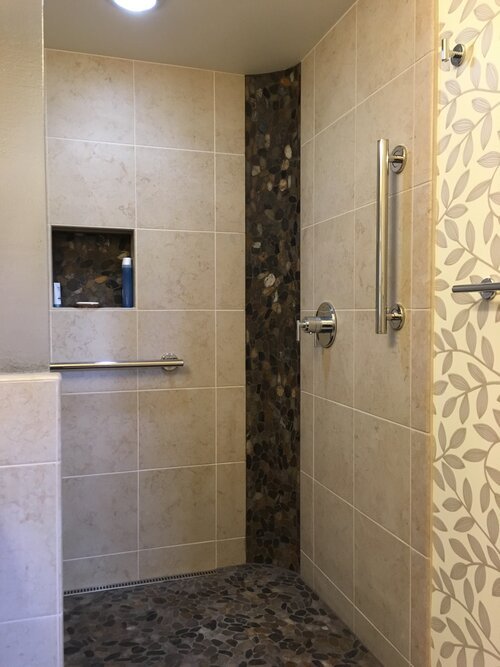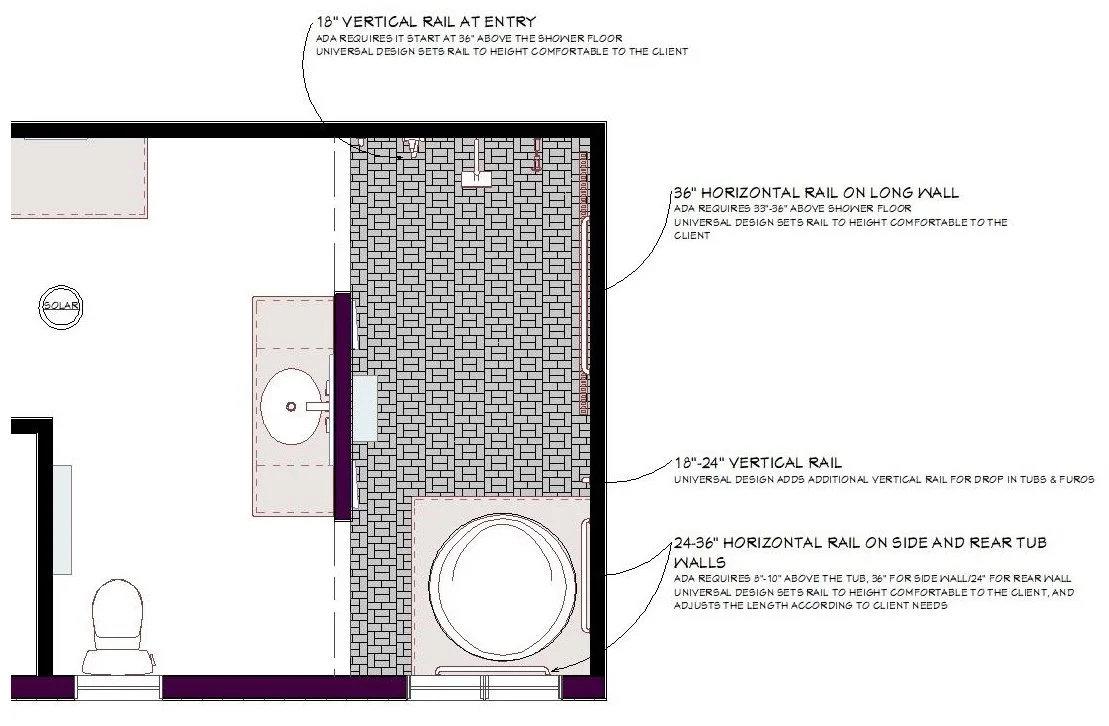Bathroom Grab Bar Placement in Universal Design
Are you looking to make your bathroom more accessible, safe and keep it stylish?
Understanding the ADA Standards Guidelines and incorporating bathroom grab bars into your design can make a significant difference. Here is the explanation of what ADA Standards Guidelines are:
“The design standards issued under the Americans with Disabilities Act (ADA) by the Department of Justice and the Department of Transportation are used to ensure access to the built environment for people with disabilities. “ - U.S. Access Board
These standards apply to commercial projects and places of public accommodation. Residential homes are not required to meet these standards. However, these guidelines provide an important standard to ensure correct and effective user ergonomics. We at Universal Interiors use these standards and tailor them to suit the needs of our clients.
In this article, we will explore the ADA Standards Guidelines, the concept of universal design, and the different types and purposes of grab bars. Get ready to transform your bathroom into a safe and stylish space!
What is Universal Design?
While ADA standards are important guidelines for public spaces, universal design tailors these standards to suit the needs and ergonomics of our clients. It is the result of products and environments designed to be usable by all people, to the greatest extent possible, without the need for adaptation or specialized assistance.
Grab Bars are not just for Hospitals
Your bathroom doesn’t have to look like a hospital or care home. There are many more options for grab bars than we see in a typical setting. And because we can coordinate the bars with the plumbing and accessories in your space, we prefer to think of them as support rails rather than grab bars. You do not have to sacrifice the design aesthetic of your bathroom for safety. Take a look at some of these beautiful options we’ve used in our projects. Below we list different types of grab bars and the purpose they serve.
Types of Grab Bars and Their Purpose
Vertical Grab Bars
Vertical grab bars are used for balance and steadying either you or your caregiver as you reach for the shower controls or step over the shower curb. For this reason, these bars are placed near the outside edge of the shower walls.
Horizontal Grab Bars
Horizontal grab bars provide support and steadying for a user in getting up and down from a shower seat, toilet seat, or if you drop something onto the shower floor. They are placed next to toilets and on one or more of the shower walls.
Diagonal Grab Bars
Diagonal grab bars are nice for instances where the occupants' heights vary. They are used on the long wall of the shower so children through tall adults can support themselves. Textured grab bars are recommended in this situation so your hand doesn’t slide down unexpectedly.
Universal Design Principles Compared to ADA Guidelines
Grab Bar Dimensions and Placements
The schematic above shows you how we chose to place our bars in a bathroom compared to ADA guidelines.
According to the ADA, the bottom of an 18” vertical bar at the entrance to the shower should be 36 inches above the shower floor. We place the bar so that the center of the bar is set to a comfortable grip height for the users. Sometimes this is 36 inches above the floor, but other times it is 42” or more above the floor.
For the horizontal bar on the long wall of the shower, ADA recommends it be centered anywhere from 33 inches to 36 inches above the floor. While that tends to be a comfortable height for most of our clients, we have adjusted it to 36” for taller clients and lowered it a bit for clients who are shorter or who also want a shampoo niche on that wall. This is also where we like a diagonal bar for wider use and aesthetics, as long as it doesn’t sacrifice safety.
Moving down the space, we come to a Japanese style soaking tub. As discussed further in this article there are proper ways to enter and exit a bathtub. So we chose to put a vertical bar just outside the tub to hold onto while maneuvering in and out of the tub. ADA does not have a guideline for this approach. ADA will advise that next to a tub there be horizontal bars 8-10 inches above the tub on the side and rear walls. Universal design mounts the bars at about the same height, based on our client’s stature, but we also take into consideration the placement of items around the tub and adjust the length of the bars accordingly.
The toilet in this bathroom, like many, can only have one standard grab bar placed next to the toilet. For many of us that is all we need for now. Eventually, the time may come where this is not enough support and we see many clients placing a portable toilet seat with bars over their existing toilet. To avoid this scenario, during construction we install wood blocking in the wall next to the open side of the toilet. This way the client can install a drop-down grab bar in the future, but they are a bit clunky, so many of our clients don’t want them until they need them.
Preparing for grab bar installation is just as important as installing them, so we ensure all our bathrooms get enough blocking for future grab bar installation.
Tub versus Shower
Most people think of showers when thinking about accessible bathing. However, tubs can be very therapeutic and sometimes required for certain individuals. This is why we include tubs in this discussion.
What matters with tubs when it comes to accessibility is the safety of getting in and out of it. Stepping over the front of a standard tub should be avoided but may be necessary. Wherever possible, universal design uses drop-in tubs which allow for a platform around the tub where the user can sit on the edge and, while holding the support rail, swing their legs over and into the tub. This avoids stepping in and potentially slipping before both feet are securely on the tub floor.
Incorporating grab bars into your bathroom design is not only a practical choice but also a stylish one. Because we at Universal Interiors understand these ADA Standards Guidelines and the different types and purposes of grab bars, we can create a safe and accessible space for you. Whether you're a homeowner or a business owner, these guidelines provide essential standards to ensure correct and effective user ergonomics.
Remember, your bathroom doesn't have to look like a hospital or care home. So, transform your bathroom into a safe and stylish space by adding grab bars and embracing universal design principles.




